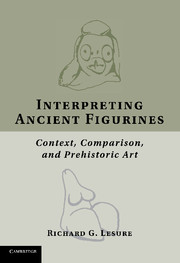Book contents
- Frontmatter
- Contents
- Figures and Tables
- Acknowledgments
- Introduction
- One Universalist Explanation and Prehistoric Figurines
- Two Comparison and Context
- Three The Questions We Ask of Images
- Four A Cross-Cultural Explanation for Female Figurines?
- Five Mesoamerican Figurines and the Contextualist Appeal to Universal Truths
- Six Figurines, Goddesses, and the Texture of Long-Term Structures in the Near East
- Seven On Figurines, Femaleness, and Comparison
- Notes
- Bibliography
- Index
One - Universalist Explanation and Prehistoric Figurines
Published online by Cambridge University Press: 01 March 2011
- Frontmatter
- Contents
- Figures and Tables
- Acknowledgments
- Introduction
- One Universalist Explanation and Prehistoric Figurines
- Two Comparison and Context
- Three The Questions We Ask of Images
- Four A Cross-Cultural Explanation for Female Figurines?
- Five Mesoamerican Figurines and the Contextualist Appeal to Universal Truths
- Six Figurines, Goddesses, and the Texture of Long-Term Structures in the Near East
- Seven On Figurines, Femaleness, and Comparison
- Notes
- Bibliography
- Index
Summary
“The first god was a goddess!” proclaimed Etienne Renaud in 1929. A dozen tiny figurines from Arizona, perhaps two thousand years old, were the immediate inspiration for Renaud's “bold paradox.” Just inches tall, they were roughly shaped in clay with crude facial features and punctate designs suggesting clothing or ornamentation. All had prominent, modeled breasts. To Renaud, these were “fetishes of the feminine principle of fecundity and reproduction” depicting “a goddess of life.” He supported this contention by embarking on a world tour of ancient female imagery. The itinerary included Western Europe, the Balkans, Southern Russia, Anatolia, Cyprus, Crete, Egypt, and the Near East before he crossed the Atlantic again to finish in Nicaragua and Panama. In case after case, female figurines appeared in the most ancient archaeological strata. Surely, this revealed a deeply rooted “worship of the life-giving mother” and “betray[ed] the same psychology in primitive man of different continents.”
Renaud's article succinctly lays out a once-common universalist vision in the study of prehistoric figurines. The goal was to account for the perception that the earliest prehistoric figurines, everywhere, were female. Today, archaeologists are immediately suspicious of Renaud's sweeping cross-cultural generalizations. His drawings, in which a single image stands for each region (Egypt, Crete, Nicaragua), at best seem quaintly amusing. We now insist on serious attention to local variation and context. We also are suspicious of the assumption that the category “female” is stable across contexts. Ambitious cross-cultural explanations are regarded with skepticism.
- Type
- Chapter
- Information
- Interpreting Ancient FigurinesContext, Comparison, and Prehistoric Art, pp. 10 - 25Publisher: Cambridge University PressPrint publication year: 2011



